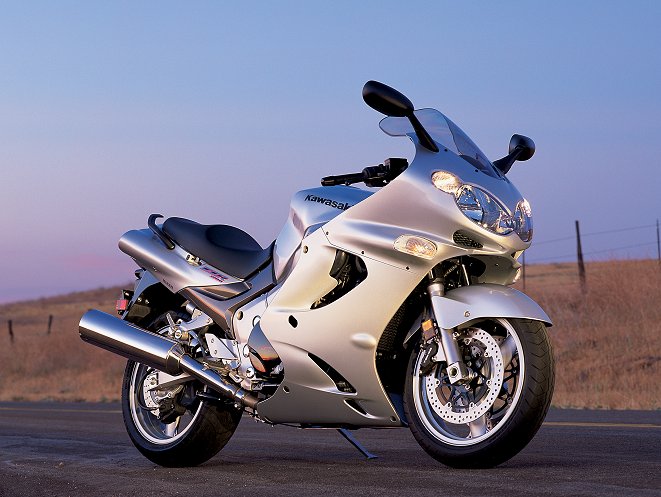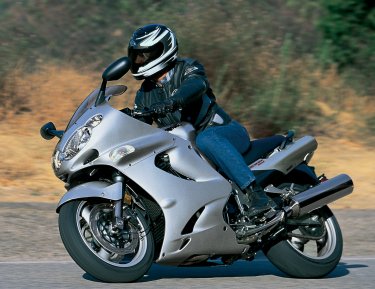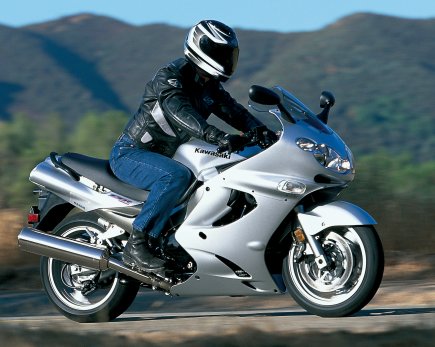
We have already provided MD readers with a preview and a Part One to this ride review. We put quite a few miles, and hours, on the 2002 ZZ-R1200. This is our final report on this new machine.
The engine in the ZZ-R is its soul, in more ways than one. It is related, to some extent, to the engine contained in the ZRX1200R model introduced by Kawasaki last year. Our review of the big ZRX raved about this in-line four. Surprisingly, the ZZ-R version of this motor delivers even more power (sorry, but we did not get a chance to dyno the bike). The two-muffler design undoubtedly has something to do with this . . . allowing the engine to breathe a bit better. Kawasaki made several other changes to the engine, however. Displacing a total of 1164 cc, the ZZ-R has a new cylinder head design, with a new water jacket and bolt layout. The combustion chambers are fed by downdraft carburetors (40 mm each) controlled by Kawasaki’s K-TRIC throttle position sensor system. Rocker arms are now sintered-tipped, rather than chrome-tipped, for longer wear and less friction.
Twin fuel pumps are utilized (one feeding cylinders 1 and 2, while the other feeds cylinders 3 and 4) to make sure plenty of fuel reaches the large and powerful motor. Although the crank is based on that found in the ZRX1200, it is “newly-balanced” for this application.
Pistons in the ZZ-R are a new design, as well. They contain reinforcing ribs, for instance, similar to those found in the ZX-12R.

As indicated in Part One, the frame is derived from the ZX-11, but features 10 mm thicker rails, as well as a new steering head casting (with internal, reinforcing ribs). A new sub-frame is made from steel (rather than aluminum) to accommodate after-market saddlebags.
In the chassis department, lighter handling was achieved by changing the steering head rake from 26 to 25 degrees, and reducing steering offset from 35 to 30 mm. The steering head bearings are now ball bearings, rather than tapered bearings — contributing to the lighter handling, and a smoother steering feel. The new swingarm is lighter, and is based largely on the ZX-9R design. The swingarm pivot point has been lowered to improve traction and squat characteristics.
The rear shock is new, as are the linkage rods actuating it (15 mm longer). Easily accessed preload adjustment (under the right edge of the seat), as well as rebound adjustment (four position), is featured in the rear suspension system. The 43 mm fork makes do with pre-load adjustment only. The front brake calipers now have staggered piston sizes, with the leading piston 30 mm, and the trailing piston 34 mm. The front discs are huge, 320 mm items. The rear brake disc is 250 mm, and it is squeezed by a caliper taken directly from the ZX-12R.

The riding position has been significantly relaxed from that of the ZX-11, with the handlebars 15 mm closer to the rider and the foot pegs 10 mm lower and 20 mm forward of their prior position. Additional comfort comes courtesy of a very significant improvement in rider wind protection with the redesigned fairing.
The very thorough, clean and legible instrumentation contains several analog dials (for tachometer, speedometer, fuel level and engine coolant temperature), as well as a digital clock, trip meter, turn signal indicator, oil pressure warning light and high beam indicator.
As mentioned in Part One, we found the new riding position quite comfortable, yet still relatively sporty. The one complaint would be with the seat shape, which tends to push the rider forward a bit on longer rides. Wind protection is outstanding, and a clear cut above the sportbike class. Mirrors are wide enough to be useful, and relatively free from vibration.

Kawasaki seems to have traded a little bit of stability for quicker steering this year in several of its models. The ZZ-R1200 is no different, and the bike does change directions quite well for its size and weight. It retains plenty of stability, as well (it had lots to trade), and has a nice, fluid feel when transitioning through sweeping corners.
Understandably, the ZZ-R does not like to change directions as quickly and decisively as a smaller, lighter sportbike. If you ride the bike in this fashion, you will notice the front end of the bike (with the smallish, 43 mm fork tubes) responding a bit slower than the latest sportbikes. Ground clearance was surprisingly good — allowing high corner speeds without anything touching down.
As a mile eater, the ZZ-R1200 is in its element. The comfort described above is combined with a smooth ride, a strong, torquey motor, and good gas mileage — an observed 45 miles per gallon (which yields more than 200 miles from the 6.1 gallon fuel tank). A slight buzziness at 5,000 rpm, and off throttle, did not pose a significant problem.
This is a big, fast motorcycle, and the brakes are up to the task at hand. We would have to rate the brakes, overall, in the “good” to “very good” category (just behind sportbike-levels of braking). One thing we like about the braking system is the inclusion of 320 mm discs up front. This large, stock disc size makes brake upgrades easy and relatively affordable. A simple change in pad material and brake line construction (i.e., steel-braided lines) would yield all the stopping power you are likely to want. As delivered, the brakes are relatively linear, with good feel, but require a strong pull on the lever when braking aggressively.
The transmission shifts positively, but requires a good boot and is a bit notchy.

Nighttime illumination is quite good from the dual-H4 bulbs and multi-reflector headlight design. We would like to have seen an easily accessible, remote headlight height adjustment mechanism, however. Sport tourers designed for passengers and luggage (bags will be available) need this feature, because the added weight in the rear can significantly raise the headlight beam angle. This is offset to some extent, however, by the remote preload adjuster that can help keep the same ride height in the back after adding that passenger or luggage.
Styling was extremely well received by onlookers. The rear of the motorcycle might polarize some observers, but we received nothing but compliments regarding the design.
The ZZ-R1200 is a very interesting bike, and surprising in many ways. It is much more than a “warmed over” ZX-11. It would be a good choice for the rider looking to hang with his sportbike buddies, while experiencing much greater comfort and versatility from his machine. Very few bikes will walk away from the ZZ-R1200 in a straight line (I can think of only two, off hand, including Kawasaki’s own ZX-12R and Suzuki’s Hayabusa), and, ridden well, the bike will hang with just about anything on the street through the twisty stuff. At the same time, it provides a reasonable platform for distance touring, with or without a passenger.
The 2002 ZZ-R1200 is available now at U.S. dealers. MSRP is $10,499. See Kawasaki’s web site for additional details and specifications.





